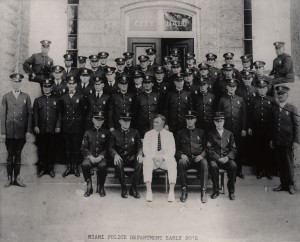
Crime as Subculture: A Miami Legacy
The criminal underground — or sometimes more above ground than not — has held a storied place in Miami’s lore from its very founding. From its maritime strategic position at the bottom of the country, ideal for any kind of smuggling, to its notorious corruption and celebrity murders, illegal activity and Miami have had a twisted but close relationship. So why not an exhibition called “Crime in Miami” at the newly renamed HistoryMiami museum (formerly the Historical Museum of Southern Florida, the name change was due to a campaign to celebrate, dig this, its 70th anniversary in April).
Through photographs, interactive devices, and some great factoids, “Crime” is meant to be an educational trip down our 20th-century’s fascinating crime-laden lane more than a lurid or graphic snapshot. It also aims to highlight crime’s counterpart — law enforcement — as well.
Not surprisingly, Prohibition played a big role in Miami’s rogue past, so there are photos and documentation about illegal stills, “rumrunning” through the Caribbean, and the most famous gangster of the era, Al Capone (while Chicago-based, he owned a 14-room retreat on Palm Island and spent his time here at nightclubs and gambling at race tracks; he was convicted of tax evasion in 1931).
Even after alcohol was legalized, dubious development schemes and even more dubious police practices thrived, so the 1950s also offers up a treasure trove of tidbits here. Then of course, the cocaine cowboy days erupted in the 1970s, along with rioting and other social upheavals, and Miami’s connection with crime was cemented. As movies from Key Largo and Scarface to TV’s Miami Vice emphasized, we claim a colorful place in America’s story.
There’s lots of stuff to illustrate this history aside from documents, and stuff that works well for adults and kids alike. You can have your mugshot taken along with fingerprints. There’s a forensic center that guides you through modern-day sleuth solving, and maybe most dramatically, a booking station and holding cell — crime can seem sexy, but if you have to pay, it’s pretty glamour-free.
Another part of Miami’s lore is that it has little lore — in other words it’s a fairly rootless, history-less city, which this museum and exhibit disproves with all that it shows. Miami’s past is fascinating, difficult, traumatic, and beautiful. During the hot summer months it’s a good time to explore this history through shows such as “Crime,” which has been screening films and hosting lectures throughout. It runs through the end of August.
“Crime in Miami” through Aug. 29 at HistoryMiami, 101 West Flagler St., Miami (parking at the Miami-Dade Cultural Center Parking Garage, 50 NW 2nd Ave): 305-375-1493; www.hmsf.org.
Recent Content
-
Artsarticle ·
-
Artsarticle ·
-
Artsarticle ·


